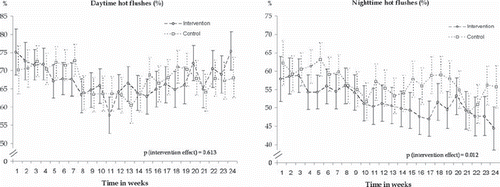Figures & data
Table I. Base-line characteristics and quality of life in the intervention and control groups. QoL was estimated by means of the Short Form-36 quality of life (SF-36) score and the menopause-specific quality of life score (Women's Health Questionnaire (WHQ)).
Table II. Women's Health Questionnaire and SF-36 health-related quality-of-life scores among the intervention and control groups—6 month intervention scores and change from base-line to end.
Figure 2. Observed weekly frequencies (%) and 95% confidence intervals of day-time (left) and night-time (right) hot flushes based on mobile phone questionnaire during 24 weeks of intervention.

Table III. Number of responses to phone-based diary and observed frequency (%) of hot flushes by intervention month and group. Estimated proportion of hot flushes from multilevel mixed logistic regression.
Table IV. Changes in quality of life (WHQ and SF-36 scores) by frequency of aerobic training sessions (from phone-based diary and heart rate belt information). Intervention group women (n = 78). Significance between the frequency groups tested with non-parametric Kruskal–Wallis test.
Table V. Aerobic training-related variables (fitness and body composition) at base-line, after 6 months intervention, and change between base-line and 6 months. Differences between groups were tested by t test.
